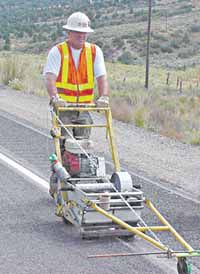| A Utah Department of Transportation worker applies reflective tape along a section of U.S. Highway 6. UDOT is testing the reflective tape as a possible replacement for painted lines on state roads in the future. |
One primary complaint raised by motorists traveling on roads during the winter season focuses on faded traffic lines.
“We get a lot of calls about that despite the fact that, in many places, we repaint the lines three times a year,” indicated Dave Babcock, maintenance supervisor for the Utah Department of Transportation in the Carbon-north Emery area. “That is what people seem to get upset about.”
To address the concern, UDOT tests dozens of paints each year looking for coatings that show up in all weather conditions and withstand the wear and tear. Strips of color painted across a highway at various locations frequently signal the tests are in progress.
“One of the problems we have is that all we can use is water-base paint because of environmental concerns,” pointed out Babcock. “That creates problems for painting during the cold weather.
“First of all, the paint doesn’t stick well to the pavement when it is cold. And secondly, the water in the coating breaks the application machines if it freezes up,” explained the maintenance supervisor.
For years, highway departments throughout the nation have been looking for alternatives to remedy the situation. Along that path, UDOT is testing something different, something that could resolve a lot of the problems associated with paint: tape lines.
Many complaints received by UDOT are related to inadequate visibility during storms, when motorists use the highway lines to determine where the middle and the edge of the road are.
“Paint just doesn’t reflect through moisture on the road and that is the very time we need it to do that the most,” noted Babcock. “However, the tape appears to reflect just fine under those conditions”
“It’s actually guaranteed for four years and that is more life than we get out of the paint we put down,” added the UDOT maintenance supervisor.
One of the keys to putting the tape down and making it stay in place is to provide a groove on the side of the road that it can lay in, so it isn’t damaged by traffic or snow plows going over it.
The problem with that is that it costs some real money to put in the groove after the pavement has been laid. Special grinding machines must be employed to create that trough. But Babcock came up with the idea of creating the groove, instead, when contractors do a chip and seal on roads. That makes the cost to set up such a system nil.
“What is really nice is that the trough down the side of the road also makes a great marker during the day when the road is wet,” states Babcock.
The tape is now in the test stage. It was laid down in September on U.S. 6 in a test area between mile posts 203 and 212. It was then evaluated for reflectiveness with a meter. After the winter the test will be done again to see how it’s reflectivity has held up through the bad weather.
“The groove idea is a good one,” explains Babcock. “But we aren’t restricting ourselves to testing just the tape in the grooves. We are also testing paint to see if it holds up better as well.”

